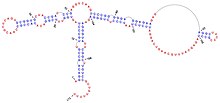The Epstein–Barr virus-encoded small RNAs (EBERs) are small non-coding RNAs localized in the nucleus of human cells infected with Epstein–Barr virus (EBV). First discovered in 1981, EBERs are the most abundant RNAs present in infected cells.[1] EBERs interact with several host proteins to form ribonucleoprotein (RNP) complexes. Although a precise function for EBERs remains elusive, roles in transformation and oncogenesis are proposed.
Background
EBER1 and EBER2 are short, 167 and 172 nucleotides in length respectively, nuclear-enriched non-coding RNAs. These two RNAs are transcribed by the host's RNA polymerase III during latent infection of EBV.[2][3]
EBERs 1 and 2 can be deleted from the viral genome without noticeable phenotypic changes, though this has never been found deleted in nature.[2] EBER expression alone can induce tumours in severe combined immunodeficient mice.[4][5]
EBER1
EBER1 associates with human ribosomal protein L22[6] and causes this protein to move from the nucleolus to the nucleoplasm.[7] EBER1 also specifically interacts with at least three host hnRNPs (A1, A2/B1 and D/AUF1).[8]
EBER2

Similar to EBER1, EBER2 is very highly expressed in latently infected cells. Unlike EBER1, the sequence of EBER2 is less conserved in related herpesviruses (~50% conservation). However, the secondary structure of EBER2 is highly conserved (see Figure 1). EBER2 is only known to bind cellular proteins (specifically, the La domain) at its terminal stretch of repeated uridines; however, it is believed that the other features of EBER2, particularly its two long and highly conserved stem-loops, may also serve as binding sites for yet unknown proteins.[9]
| This article uses material from the Wikipedia article Metasyntactic variable, which is released under the Creative Commons Attribution-ShareAlike 3.0 Unported License. |
